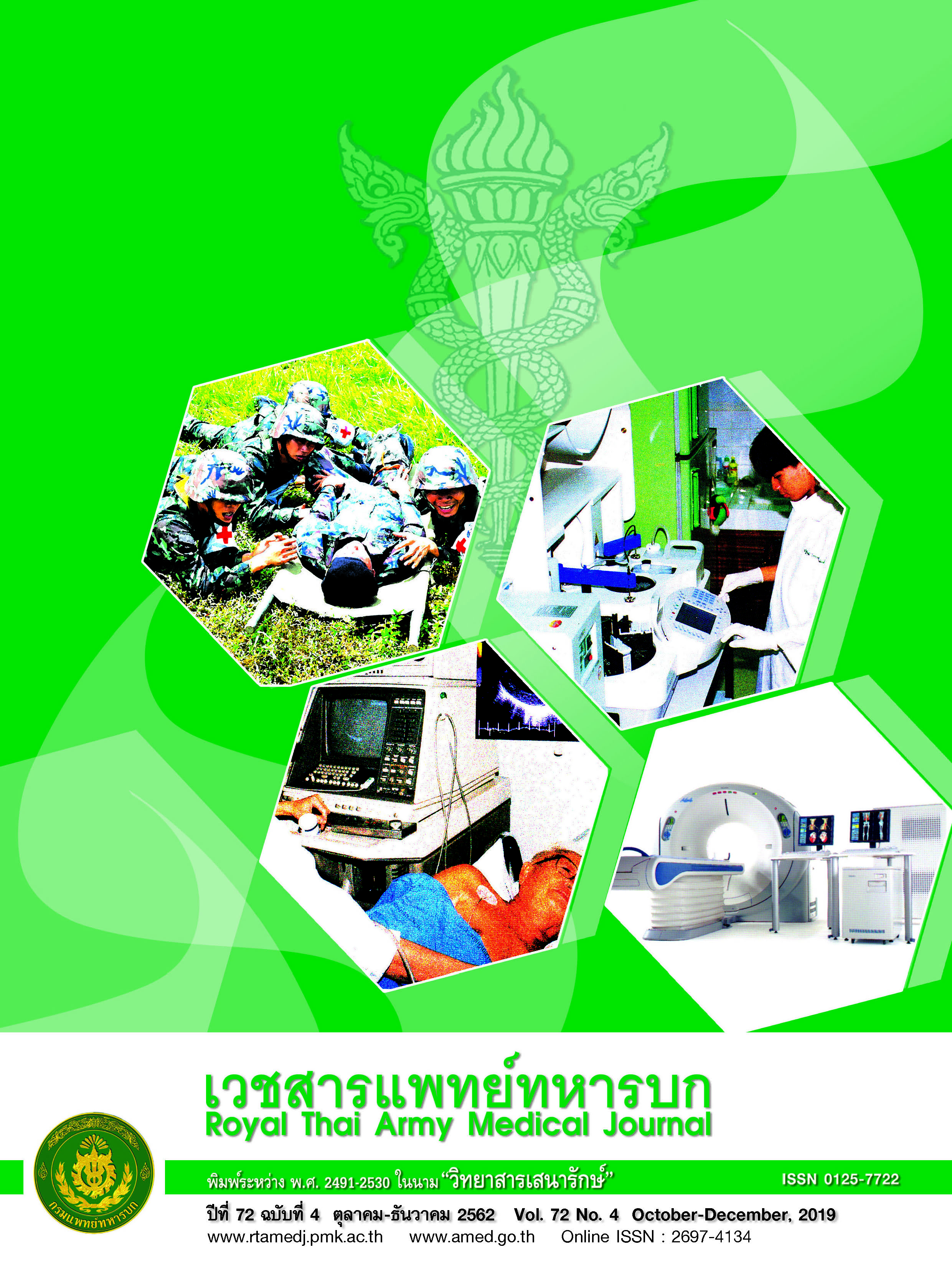พฤติกรรมสุขภาพช่องปากที่สัมพันธ์กับคุณภาพชีวิตของพลทหารแรกเข้าภาคใต้ ประเทศไทย
Main Article Content
บทคัดย่อ
บทนำ ปัญหาพฤติกรรมสุขภาพช่องปากของพลทหารเป็นปัจจัยเสี่ยงที่ก่อให้เกิดปัญหาสภาวะช่องปากและส่งผลกระทบกับคุณภาพชีวิต วัตถุประสงค์ การศึกษานี้มีวัตถุประสงค์เพื่อสำรวจพฤติกรรมสุขภาพช่องปาก คุณภาพชีวิต และความสัมพันธ์ระหว่างพฤติกรรมสุขภาพช่องปากกับคุณภาพชีวิต วิธีการ เป็นการศึกษาแบบตัดขวางเชิงวิเคราะห์ในพลทหารแรกเข้า ผลัด 2 ปี พ.ศ. 2560 ในค่ายเสนาณรงค์ อ.หาดใหญ่ จ.สงขลา ซึ่งมีระยะเวลาเกณฑ์ทหาร 2 ปี สุ่มกลุ่มตัวอย่างแบบชั้นภูมิ เก็บข้อมูลพฤติกรรมสุขภาพช่องปากและคุณภาพชีวิตด้วยแบบสัมภาษณ์ที่ผ่านการตรวจความตรงเชิงเนื้อหาและความเที่ยง ผลการศึกษา พลทหารแรกเข้าจำนวน 246 คน อายุเฉลี่ย 21.9±1.1 ปี มีพฤติกรรมสูบบุหรี่ทุกวัน ร้อยละ 93.5 และดื่มแอลกอฮอล์ทุกวัน ร้อยละ 4.9 คะแนนคุณภาพชีวิต (SF-36) 8 มิติ อยู่ในเกณฑ์ดี – ดีเยี่ยม มิติที่ได้คะแนนน้อยสุด 2 อันดับ คือ ความกระปรี้กระเปร่ามีพลัง และความเจ็บปวดทางร่างกาย พฤติกรรมสุขภาพช่องปากที่มีความสัมพันธ์กับคุณภาพชีวิต คือ การดื่มแอลกอฮอล์ สรุป พลทหารแรกเข้าที่มีระยะเวลาในการเกณฑ์ทหาร 2 ปี มีปัญหาพฤติกรรมสุขภาพช่องปากสูงซึ่งมีความสัมพันธ์กับคุณภาพชีวิต โดยผู้ที่ดื่มแอลกอฮอล์จะมีคุณภาพชีวิตแย่ลง
Downloads
Article Details
บทความในวารสารนี้อยู่ภายใต้ลิขสิทธิ์ของ กรมแพทย์ทหารบก และเผยแพร่ภายใต้สัญญาอนุญาต Creative Commons Attribution-NonCommercial-NoDerivatives 4.0 International (CC BY-NC-ND 4.0)
ท่านสามารถอ่านและใช้งานเพื่อวัตถุประสงค์ทางการศึกษา และทางวิชาการ เช่น การสอน การวิจัย หรือการอ้างอิง โดยต้องให้เครดิตอย่างเหมาะสมแก่ผู้เขียนและวารสาร
ห้ามใช้หรือแก้ไขบทความโดยไม่ได้รับอนุญาต
ข้อความที่ปรากฏในบทความเป็นความคิดเห็นของผู้เขียนเท่านั้น
ผู้เขียนเป็นผู้รับผิดชอบต่อเนื้อหาและความถูกต้องของบทความของตนอย่างเต็มที่
การนำบทความไปเผยแพร่ซ้ำในรูปแบบสาธารณะอื่นใด ต้องได้รับอนุญาตจากวารสาร
เอกสารอ้างอิง
2. Kelbauskas E, Kelbauskiene S, Paipaliene P. Smoking and other factors influencing the oral health of Lithuanian Army recruits. Mil Med. 2005;170:791-6.
3. Sutthavong S, Ukritchon S, Rangsin R. Oral health survey of the military personnel deployed to the southernmost provinces of Thailand. J Med Assoc Thai. 2014;97(2):60-7.
4. Oznur T, Akarsu S, Erdem M, Durusu M, Toygar M. Psychiatric symptoms and quality of life in military personnel deployed abroad. Isr J Psychiatry Relat Sci. 2015;52:60-5.
5. Lwanga SK, Lemeshow S. Sample size determination in health studies: A practice manual. Geneva: World Health Organization; 1991.
6. Ministry of Public Health. The 7th Thailand National Oral Health Survey Report; 2012.
7. Leurmarnkul W, Meetam P. Properties Testing of the Retranslated SF-36 (Thai Version). Thai J Pharm Sci. 2005;29(1-2):69-88.
8. John EW, Kristin KS, Mark K, Barbara G. SF-36 Health Survey Manual and Interpretation Guide; 1993.
9. Azevedo L, Martins D, Fialho J, Veiga N, Correia A. Oral health behaviors and dental caries in a sample of Portuguese militaries. Rev Port Estomatol Med Dent Cir Maxillofac. 2018;59:18-23.
10. Panicharoenrat N, Pithpornchaiyakul S, Tianviwat S. Relationship between Oral Status and Oral Health-Related Quality of Life of Early Privates in the Southern of Thailand. J Dent Assoc Thai. 2019;69(2):209-16.
11. Jacobson I, Ryan M, Hooper T, Smith T, Amoroso P, Boyko E, et al. Alcohol use and alcohol-related problems before and after military combat deployment. JAMA. 2008;300:663-75.
12. Mullie P, Deliens T, Clarys P. Relation between sugar-sweetened beverage consumption, nutrition, and lifestyle in a military population. Mil Med. 2016;181:1335-9.
13. Barrett DH, Boehmer TK, Boothe VL, Flanders WD, Barrett DH. Health-related quality of life of U.S. military personnel: A population-based study. Mil Med. 2003;168:941-7.
14. Proctor SP, Harley R, Wolfe J, Heeren T, White RF. Health-related quality of life in Persian Gulf War veterans. Mil Med. 2001;166:510-9.
15. Mbawalla HS, Masalu JR, Astrom AN. Socio-demographic and behavioural correlates of oral hygiene status and oral health related quality of life, the Limpopo-Arusha school health project (LASH): A cross-sectional study. BMC pediatrics. 2010;10:87.
16. Angkaw AC, Haller M, Pittman JO, Nunnink SE, Norman SB, Lemmer JA, et al. Alcohol-related consequences mediating PTSD symptoms and mental health-related quality of life in OEF/OIF combat veterans. Mil Med. 2015;180:670-5.
17. Peet M. International variations in the outcome of schizophrenia and the prevalence of depression in relation to national dietary practices: An ecological analysis. Br J Psychiatry. 2004;184:404-8.
18. Colak H, Dulgergil CT, Dalli M, Hamidi MM. Early childhood caries update: A review of causes, diagnoses, and treatments. J Nat Sci Biol Med. 2013;4:29-38.
19. Sack D. A high-sugar diet impacts both physical and mental health [internet]. 2013[cited 2018 Dec 23]. Available from: https://www.psychologytoday.com/intl/blog/where-science-meets-the-steps/201309/4-ways-sugar-could-be-harming-your-mental-health
20. Mayer B. How much nicotine kills a human? Tracing back the generally accepted lethal dose to dubious self-experiments in the nineteenth century. Arch Toxicol. 2014;88:5-7.
21. Watheesathokkij P. 50 Answers for smoker and non-smoker. Nonthaburi:Nonthapim Printing; 2012.


